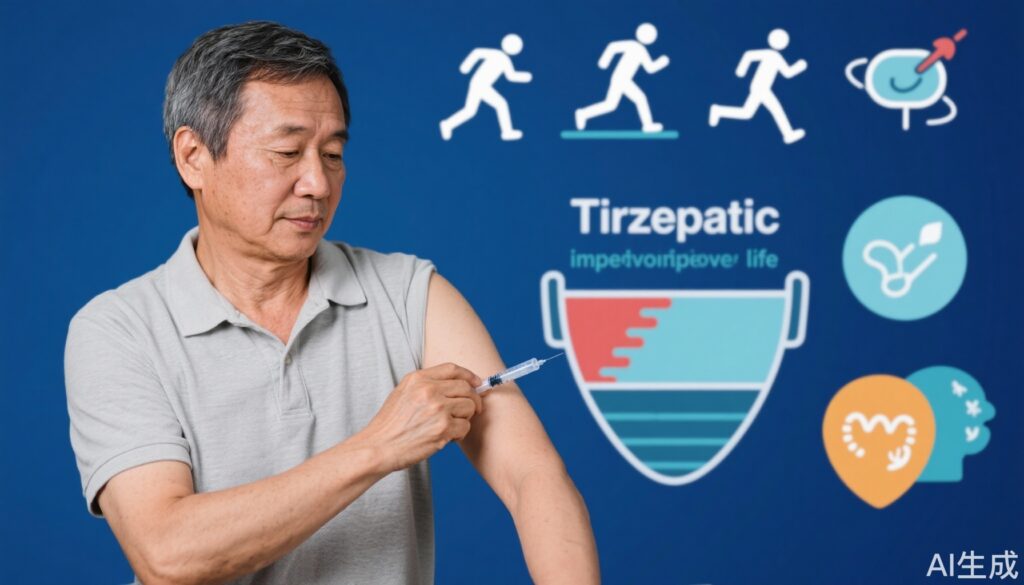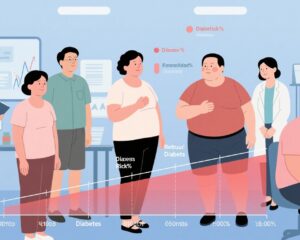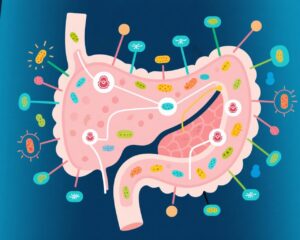Study Background and Disease Burden
Obesity and overweight conditions represent major global health challenges due to their high prevalence and association with increased morbidity and mortality. Beyond physical complications such as cardiovascular disease, diabetes, and musculoskeletal disorders, obesity significantly impairs health-related quality of life (HRQoL), impacting physical functioning, mental health, social engagement, and overall wellbeing. Despite lifestyle interventions yielding modest weight loss, maintaining and augmenting weight reduction remains difficult, and effective pharmacologic agents are necessary to improve both weight outcomes and patient-centered quality of life measures. Tirzepatide, a novel dual glucose-dependent insulinotropic polypeptide (GIP) and glucagon-like peptide-1 (GLP-1) receptor agonist, has demonstrated promising anti-obesity effects. The SURMOUNT-3 phase 3 trial aimed to evaluate tirzepatide’s impact not only on weight loss but also on HRQoL in adults with obesity or overweight who had initially achieved at least 5% weight reduction through intensive lifestyle intervention.
Study Design
SURMOUNT-3 was a randomized, double-blind, placebo-controlled trial conducted over 72 weeks involving adults with obesity or overweight who successfully lost ≥5% of their initial body weight after a 12-week intensive lifestyle program. The randomized population was assigned either placebo (N = 292) or tirzepatide at their maximum tolerated dose (10 or 15 mg, N = 287) administered via weekly subcutaneous injections. HRQoL assessments were performed at baseline (randomization) and after 72 weeks using multiple validated instruments: the Short Form-36 Version 2 Health Survey acute form (SF-36v2), the Impact of Weight on Quality of Life-Lite Clinical Trials Version (IWQOL-Lite CT), the 5-level EQ-5D Health State Index, the EQ visual analogue scale (VAS), and the Patient Global Impression of Status (PGIS) for Physical Activity. This multidimensional approach provided a comprehensive evaluation of general physical and mental health, weight-related quality of life, health state perception, and patient-perceived physical activity limitations. Subgroup analyses examined HRQoL changes in tirzepatide recipients by various weight loss thresholds (≥5%, ≥10%, ≥15%, ≥20%, ≥25%) and by presence or absence of physical function limitations at baseline defined using PGIS.
Key Findings
The trial results demonstrated that tirzepatide treatment resulted in significantly greater improvements compared with placebo across most HRQoL measures from randomization through week 72. Specifically:
1. Weight Loss and Quality of Life Improvement: Tirzepatide participants achieved substantially greater weight reduction, which correlated with numerically larger HRQoL score improvements. Improvement magnitude generally increased with higher weight loss thresholds, indicating a dose-response relationship between weight reduction and quality of life gains.
2. Physical Function Limitations and HRQoL Benefits: Participants with baseline physical function limitations experienced more pronounced enhancements in quality of life measures versus those without such limitations. This suggests tirzepatide may be particularly beneficial in improving daily functioning and wellbeing in adults whose physical abilities are initially compromised.
3. Domains of Quality of Life Improved: Beyond physical functioning, improvements were noted in mental health components, weight-related psychological and social functioning domains as assessed by SF-36v2 and IWQOL-Lite CT, indicating broad psychosocial benefits alongside physical improvements.
4. Global Health and Patient Impression: EQ-5D Health State Index and EQ VAS scores improved significantly, supporting enhanced general health perceptions. The PGIS for Physical Activity score improvements paralleled objective weight loss and reflected patient-perceived gains in physical capacity.
5. Statistical Significance: Most HRQoL improvements associated with tirzepatide versus placebo achieved statistical significance, underscoring the robustness of the findings.
Collectively, these data affirm that tirzepatide confers meaningful improvements in both physiological and patient-reported outcomes in adults with obesity or overweight.
Expert Commentary
This study provides compelling evidence that tirzepatide not only facilitates significant and sustained weight loss but also enhances quality of life, which is a critical yet often underappreciated therapeutic goal in obesity management. The multidomain assessment confirms benefits extend beyond mere weight reduction to encompass physical function, mental health, and social well-being. The greater improvements observed in those with baseline physical function limitations highlight a targeted subgroup that may derive substantial functional recovery and life quality gains. These results are consistent with mechanistic insights into tirzepatide’s synergistic dual agonist action improving glucose metabolism and appetite regulation, translating into comprehensive clinical benefits.
Nonetheless, as with all clinical trials, generalizability to broader patient populations requires cautious interpretation, and longer-term data on safety and durability of HRQoL improvements are warranted. Further head-to-head comparisons with other obesity pharmacotherapies could inform optimal therapeutic positioning. Moreover, real-world studies should assess if these HRQoL improvements translate into enhanced long-term adherence and health outcomes.
Conclusion
The SURMOUNT-3 trial substantiates tirzepatide as a transformative therapeutic agent for adults with obesity or overweight who have achieved initial weight loss through lifestyle intervention. Over 72 weeks, tirzepatide not only promoted superior weight reduction but also significantly improved health-related quality of life across multiple domains, especially among those with preexisting physical function impairments. These findings underscore the importance of addressing quality of life alongside traditional clinical endpoints in obesity treatment paradigms. Tirzepatide offers a promising option to enhance both the physiological and psychosocial health of patients struggling with excess weight, marking an advance in comprehensive obesity management.
References
Gibble TH, Cao D, Forrester T, Fraseur Brumm J, Chao AM. Tirzepatide and health-related quality of life in adults with obesity or overweight: Results from the SURMOUNT-3 phase 3 randomized trial. Diabetes Obes Metab. 2025 Aug;27(8):4268-4279. doi: 10.1111/dom.16463. Epub 2025 May 14. PMID: 40365662; PMCID: PMC12232368.
Wadden TA, Bailey TS, Billings LK, et al. Effect of Subcutaneous Tirzepatide vs Dulaglutide on Body Weight in Adults with Overweight or Obesity: The SURMOUNT-1 Randomized Clinical Trial. JAMA. 2022;327(7): 637-647. doi:10.1001/jama.2022.1015.
Mechanick JI, Hurley DL, Garvey WT. Adiposity-Based Chronic Disease as a New Diagnostic Term: Implications for Clinical Practice and Research. Endocr Pract. 2017;23(2):372-378. doi:10.4158/EP161541.RA.
National Institute for Health and Care Excellence (NICE). Obesity: identification, assessment and management. NICE guideline [NG189]. 2022.



